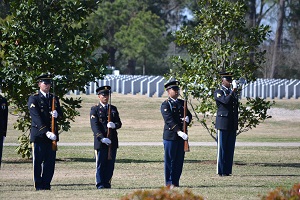Austin, Texas
05.19.2017
Story by: Sgt. Elizabeth Pena
Texas Military Department
 Service members on the Texas Military Department's Military Funeral honors team prepare to issue a three volley salute during the funeral of a U.S. veteran. (Photo courtesy of Texas Military Funeral Honors)
Service members on the Texas Military Department's Military Funeral honors team prepare to issue a three volley salute during the funeral of a U.S. veteran. (Photo courtesy of Texas Military Funeral Honors)
Memorial Day is a federal holiday to remember those that have died while serving. For most people this means a day off work and a good reason to fire up the grill and spend time with friends and family.
For the Texas National Guard’s Military Funeral Honors Team, Memorial Day comes every day — only barbecue is not included.
“We are there at the moment when the family suffers the loss of their loved one who has passed away,” said Jim Levine Jr., Military Funeral Honors State Coordinator. “We are the last living representation of the military. It’s us honoring their service every day.”
This long-standing military custom dates back to World War I, and until recently, services were only provided when manpower was available. In 2001, the National Defense Authorization Act passed a law that mandated the United States Armed Forces provide the rendering of honors in a military funeral for any eligible veteran.
“All family members want military funeral honors, they want to see that flag being folded and the sound of the trumpet, that is closure for the family,” said Ricky Williams, memorial affairs coordinator, at Joint Base San Antonio - Fort Sam Houston in San Antonio, Texas.
The family member or next-of-kin of the veteran must request honors through their funeral director. The funeral director then contacts the appropriate military service to arrange for the funeral honors detail.
Most Texas veteran memorial requests are processed through the casualty assistance office of Fort Sam.
“We cover everyone from Buda to Mexico and Beaumont to El Paso, active duty, reserves and National Guard,” said Williams. “We average 2,250 services a year.”
Williams assigns the services to Military Funeral Honor teams based on their component, area of responsibility and availability. In instances where active duty teams are over tasked, Texas guardsmen can honor any veteran in Texas.
“We depend on the Texas National Guard to help us make the family happy by coming out and performing funeral honors because we don’t have the manpower without them,” said Williams.
Recently, the team conducted a joint memorial service to honor a veteran from the Tuskegee Air Force.
“We did a joint service for a Tuskegee Airmen from WWII with the Air Force,” said Levine. “Since he was a pilot in the Tuskegee Air Force, we were able to do that with him. The Air Force did the flag folding we did the firing party, it was a great deal.”
The Texas Honor Guard has approximately 14 full-time Soldiers and 25 traditional Guardsmen. Regardless of the veteran’s military branch, Texas Guardsmen treat every service with honor and respect.
“It’s an honor for me to do this,” said Texas Army National Guard Sgt. Jonathan Strother, assistant team leader for Military Funeral Honors. “Whether they served in Vietnam, WWII or whatever era that they served, we want to leave a lasting impression of our sincerity and appreciation for their veterans services.”
Strother joined the team in 2011 as a bugler and worked his way up to an assistant team lead. He is the first Texas Guardsmen to perform nearly 1,900 services.
His leadership role allows him to instill his knowledge and expertise to incoming Soldiers.
“What I tell the young Soldiers coming in is be professional, this is not an easy job, we are on call seven days a week and we don’t usually get weekends off,” said Strother. “It is a very stressful job dealing with death and the families, but it is a very rewarding in the same sense.”
Through the military funeral honors program, Texas Guardsmen are able to share their passion of providing the family one last military honor.
“The family sometimes doesn’t see the honor behind their veterans’ service, they just know that he/she sacrifices; they are gone a lot and they deploy a lot,” said Levine. “But when they see our guys at the funeral, doing the flag folding, presenting the flag, playing the taps, we are honoring their service so therefore, for the family we are honoring their sacrifice.”
As you celebrate your Memorial Day this year, please take a moment to remember those that have given their lives for our freedom, and their families still here.